Q-R
| refers to an ad research rating that gauges how easily a celebrity is recognized -- and how well the celebrity is liked | ||
|
refers to an on-screen film technique of focus change that blurs the focal planes in sequence, forcing the viewer's eye to travel to those areas of an image that remain in sharp focus; the focus changes from an object in the foreground to an object in the background or vice versa, to direct, shift, and steer the attention of the viewer forcibly from one subject to another; also known as selective focusing or pull focus |
 Example: the scene in Desert Hearts (1985)when Vivian (Helen Shaver) realized that lesbian Cay (Patricia Charbonneau) was naked in her bed behind her, Example: the scene in Desert Hearts (1985)when Vivian (Helen Shaver) realized that lesbian Cay (Patricia Charbonneau) was naked in her bed behind her,  or the foreground image of a spider-web in Spider-Man (2002) or the foreground image of a spider-web in Spider-Man (2002) |
|
| also known as the MPAA (Motion Picture Association of America) film rating system, first officially instituted in late 1968; it refers to the ever-evolving classification system for films usually based upon age-appropriateness, and the judgment of a film's suitability for various audiences, in terms of sexual content, offensiveness, or violence; see also censorship |
Examples: "G-Rated or General Audiences," "PG-Rated or Parental Guidance Suggested," "PG-13," "R-Rated or Restricted under 17," and "NC-17, or No One 17 and Under Admitted" (originally known as the X rating), are examples of ratings; the X-rating is not trademarked / copyrighted by the MPAA; NR (not rated), meaning that a film was not submitted for ratings, is sometimes used in place of X. Pornographic films often use "XXX" to imply a rating stronger than X. |
|
| a quick shot that records a character's or group's response to another character or some on-screen action or event; often accompanied with a POV shot; reaction shots are usually cutaways. | ||
| actual time it would take for an event to occur in reality, as contrasted to filmic time (time can be sped up or slowed down). Real and filmic time often coincide for long sequences within a film; also see running time. |
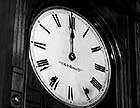 Example: High Noon (1952)was specifically shot in real-time with frequent reference to clocks ticking closer and closer to the noon-time showdown. Example: High Noon (1952)was specifically shot in real-time with frequent reference to clocks ticking closer and closer to the noon-time showdown. |
|
| filming so that the reality outside the camera is shown in a neutral style with as little distortion and interference as possible; realism is attained by long, uninterrupted takes, deep focus shots, and other filmic techniques; contrast to expressionism; similar to the 'reality' of docudramas | Examples: Woody Allen's Husbands And Wives (1992); Bergman's Scenes From a Marriage (1973) | |
| a special effects technique to create backgrounds, in which actors are filmed in front of a screen on which a background scene is projected; commonly used in early films to produce the effect of motion in a vehicle. Also see process shot, process photography, or back projection. |
 Example: rear projection in Written on the Wind (1956), or the many films with shipboard scenes of two actors standing near a railing behind which are rear-projected waves and sky Example: rear projection in Written on the Wind (1956), or the many films with shipboard scenes of two actors standing near a railing behind which are rear-projected waves and sky |
|
| literally, to "roll out" a welcoming 'red carpet', laid down for major ceremonies (film premieres, awards ceremonies) to signify an important, honorary event with dignitaries and esteemed guests attending; often the locale for live interviews and photo opportunities |
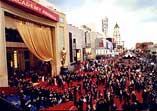 Example: the red carpet entryway for the Academy Awards show Example: the red carpet entryway for the Academy Awards show |
|
| an instance of foreshadowing that is deliberately planted to make viewers suspect an outcome--but the audience is to be deceived - the opposite happens and the false clue 'plant' is irrelevant; often done for humor, irony, or for other thematic reasons; contrast to McGuffin | Example: the various clues, all to subvert and confuse, that are unrelated to the real reason for Michelle Pfieffer's paranormal beliefs and confusion in What Lies Beneath (2000). | |
| refers to a film project that was in production, but lost its financial backing - resulting in a premature abandonment by the studio; aka a film in turnaround | ||
| refers to a plastic or metal spool for winding film; also, earlier films were measured in reels (one reel = about 10 minutes of running time). |  Example: typical film reel |
|
| a film production that re-creates an actual event as closely as possible | Examples: Glory (1989), Nixon (1995). | |
| refers to how one film in its storyline (through dialogue, images) alludes to, recalls, or refers to another film; similar to homage |
Examples: the movie that E.T. (in Spielberg's E.T.: The Extra-Terrestrial (1982)) is watching at home on TV and that Elliot re-enacts in his Science class is the John Wayne classic The Quiet Man (1952);
|
|
| refers to a studio releasing a work subsequent to the original or initial release; similar to re-release | ||
(or released) |
refers to the first distribution and general public exhibition of a film to theatre audiences for viewing. | |
| refers to a later production (of a previous film), with different credits, script, and cast; a redone, second version of a film's narrative and subject matter; remakes have been common throughout all of film history. |
Examples: The Jazz Singer (1927) remade in the 50s as The Jazz Singer (1953) with Danny Thomas, and in the early 1980s as The Jazz Singer (1980)with Neil Diamond; also What Price Hollywood? (1932) became A Star is Born (1937) - with Janet Gaynor, and A Star is Born (1954) - with Judy Garland, and A Star is Born (1976) with Barbra Streisand; and the unnecessary, meticulous shot-by-shot remake of Psycho (1960) by Gus Van Sant in 1998 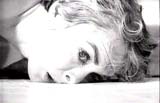 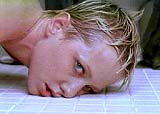 |
|
| refers to that portion of film grosses that goes to film distributors; also refers to videocassette (or DVD) rentals | ||
| the revival or rebroadcast of a work by the original distributor, studio, releaser, or broadcaster. | Example: Disney's re-releases of its animated films every five to seven years. | |
| refers to the funds kept or saved by a producer in case supplementary shootings (reshoots) are required - often occurring after test screenings or decisions made by studio executives | ||
| the outcome, or the "untying" of tension in the scenes after the climax of a film; refers to how things turned out for all of the characters; some films abruptly end without a scene following the climax; aka denouement | Example: the original, non-studio version of Don Siegel's ultra-paranoid Invasion of the Body Snatchers (1956) was softened with the addition of a framing device ('bookends') at the film's beginning and end), to change the film's resolution and make it less grim | |
| usually a tribute, exhibition, or 'looking back' at a film star's, artist's or director's work over a span of years with a comprehensive compilation or montage of film clips or excerpts; also known as a retro; also, in terms of a screenplay, a film in which nearly the entire story is looking back in time at events that have already taken place, usually accomplished by flashback | Example: Sunset Boulevard (1950) - a film told almost entirely as a backwards-looking retrospective | |
| a basic camera angle composed of a shot photographed from the opposite (or reverse) side of a subject to provide a different perspective or different angle from the preceding shot; in a dialogue scene between characters, a shot of the second participant is commonly composed as an over-the-shoulder shot; sometimes known as an 180 degree angle shot or change in perspective; the alternating pattern between two characters' points of view is known as shot/reverse shot |   Example: a typical dialogue scene with shot/reverse shot between two characters in Written on the Wind (1956). |
|
| refers to a trick camera effect, created by running film backwards in the camera or during optical printing; aka reverse action | ||
| refers to films that present an apparent genrestereotype and then subvert, revise, or challenge it; aka deconstruction |
 Examples: Altman's McCabe & Mrs. Miller (1971), and The Long Goodbye (1973); Arthur Penn's Little Big Man (1970) (shown here); the sword-and-sorcery Dragonslayer (1981, UK), or Costner's Dances With Wolves (1990) Examples: Altman's McCabe & Mrs. Miller (1971), and The Long Goodbye (1973); Arthur Penn's Little Big Man (1970) (shown here); the sword-and-sorcery Dragonslayer (1981, UK), or Costner's Dances With Wolves (1990) |
|
| film or exhibition theatres that are dedicated to emphasizing or specializing in only one type of film - such as foreign films, older films, silent films, classics, rarely-screened films, etc. | Example: the Film Forum in New York City, founded in 1970, which exhibits well over a hundred different classic films a month on three screens; one screen features a theme every month (i.e., Greatest Westerns, Paramount Before the (Hays) Code, Golden Age of Film Noir (1941-1958)) | |
| a production worker on set during film-making who sets up, hangs, and focuses lighting equipment, and constructs scaffolding | ||
| refers to exploitation films (such as "sex-hygeine" films) with controversial content (disguised as educational medical information) that were heavily promoted and shown on the road, and would be packed up quickly in case of the authorities; also refers to films that were released early and shown in prestigious theatres | 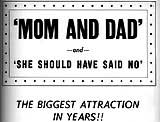 Example: showman Kroger Babb's Mom and Dad (1945), or Child Bride (1938) Example: showman Kroger Babb's Mom and Dad (1945), or Child Bride (1938) |
|
| a French term literally meaning 'novel with a key'; in film terms, refers to a film in which actual persons/events are disguised or masked as fictional characters - but with a 'key,' the true persons/events are revealed | Examples: Citizen Kane (1941) - with similarities between Kane and newspaper tycoon William Randolph Hearst | |
| refers to a camera rotation - which can be a vertical or horizontal pan; or it may refer to a camera move in which the camera is moved in a complete (or half) circle to produce a spinning, disorienting effect to the viewer; a partial rotation is termed a tilt | ||
| an animation technique in which images of live, motion-picture action footage are traced frame by frame (manually or automatically) by animators; now a process that uses computers, although originally this was done by hand; see also motion capture | ||
| an early edited (or 'cut') version of a film - with all the pieces of the film assembled in continuous, sequential order, but without any fancy editing; also sometimes known as first cut; one of the stages toward the final cut; often used in a focus group screening. | ||
| a measure of the duration or length of a film, usually about two hours for a feature film. | ||
| the prints of takes (of the camera footage) from one day's shooting, usually without correction or editing, for examination by the director before the next day's shooting; aka daily-ies | ||
źródło:www.filmsite.org
 and in Electric Dreams (1984) (pictured), Edgar the computer watches TV - in one sequence he views
and in Electric Dreams (1984) (pictured), Edgar the computer watches TV - in one sequence he views